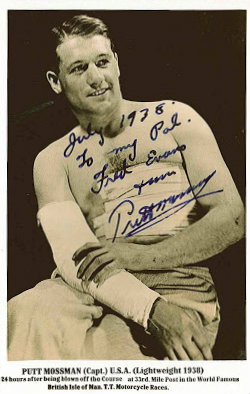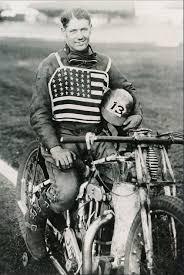PRE WAR STUNTMAN PUTT MOSSMAN


|
Orren "Putt" Mossman was born on the Mossman family farm in Hardin County, Iowa, near Hubbard and Eldora on 8th July 1906. He was the pre-war equivalent of Evel Knievel.
|
"Captain Putt" Mossman was billed as the "undisputed world's champion stunt motorcyclist" and toured the world in spectacular mechanized acrobatics, which also included automobiles. Horseshoe pitching became an organized sport in Canada after Putt Mossman came to Ontario in 1925 and gave a pitching demonstration of how to throw specialized ringers. Many of his spectators were teenagers.
Mossman was known as "The Man of a Thousand Skills", which included motorcycle stunts, horseshoe pitching, boxing, wrestling, baseball, basketball, acrobatics, musicianship, radio & TV artistry, auto racing, marksmanship, and many others. Many of Putt's stunt riding feats have never been equalled or surpassed. Mossman made three complete tours around the world, through Europe, Africa, Australia, New Zealand, Japan and fifty other nations as well as every state in the continental United States and Canada.
In 1936 he was touring along with an American speedway team and to coincide with the meeting at Hackney, Putt Mossman’s Troupe and his team of stunt riders performed their tricks in front of the east end crowd at the Waterden Road stadium.
Putt Mossman died on the 8th September 1994 (aged 88) at Benton, Marshall County, Kentucky, USA.
More can be found on Putt on the article below written by John Hyam.


Click here to see Putt Mossman 1936 Stunt Practice
Putt Mossman by John Hyam
To those with memories of pre-war speedway, American Putt Mossman is probably best known as being one of the world’s leading stunt motorcyclists of the 10 years or so leading up to that start of World War Two in September 1939.
The fact that Mossman has a place in the American Motorcycle Association’s ‘Hall of Fame’ may surprise many. It includes legends like USA road racer Kenny Roberts and, from speedway the list includes Wilbur Lamoreaux, Mike Bast, Jack Milne and Lloyd ‘Sprouts” Elder. Also there is an enigmatic figure of the 1920s, Cecil Brown, who was involved in the long-track racing of that period that led to the start of modern speedway.
So, how does Mossman figure? It seems the Americans have given him status for his undoubted ability as a stunt motorcycle rider. But he also gets rated because of his ability in flat-track racing (a motorcycle sport on one-mile and half-mile ovals) as well as speedway.
Mossman rode speedway in the USA, Japan, New Zealand and Australia in pre-war years. And he also raced in Britain in 1936, when his team of stuntmen included some well-known speedway riders like Manuel Trujillo, Sam Arena, Bo Lisman and Charles ‘Pee Wee’ Cullum. The latter was also the clown for the stunt troupe, but he was a top class rider as he proved in 1949 and 1950 when he rode for Belle Vue. And Cullum also won an unofficial world title at the Buffalo Stadium in Paris in 1936.
The 1936 tour of Britain saw the Americans in action against tracks in the National League’s Second Division, as well as appearing in stunt acts. They were back again in 1938, and Mossman’s form when involved in speedway was enough for Bristol to try - unsuccessfully as it happened - to sign him for the 1939 season. The Control Board refused to sanction the deal.
In Europe, Mossman also managed to claim a place in the 1938 Isle of Man TT road races as the official American entrant. No story book ride for him - he crashed heavily and spent 10 days in hospital.
Mossman and his troupe performed many stunts. They included crashing through plate glass and riding through walls of flame, as well as one trick in which Mossman rode a motorcycle which had a 6ft ladder attached to it. His wife used to climb up one side of the ladder and down the other as Putt maintained a steady 35mph.
His favourite trick, mainly used in New Zealand and Australia, involved a midget car which had a ramp fitted from the back, over the driver’s head, and down across the car’s bonnet. Mossman would roar up from behind on a speedway bike then ride across the ramp and come down in front of the midget.
When speedway resumed in Britain in 1946, Mossman offered British speedway promoters the chance to book his stunt team for another tour, but post-war currency restrictions involving the exchange of sterling into US dollars saw the idea founder. A pity because it could have added entertainment spectacle in those early post-war years.
After that, little more was heard of this interesting character until the AMA honoured him, deservedly perhaps, with ‘Hall of Fame’ status a few years ago.

|